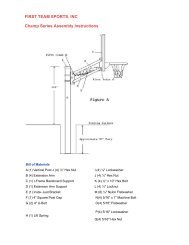Owners Manua - BBQ Grills
Owners Manua - BBQ Grills
Owners Manua - BBQ Grills
You also want an ePaper? Increase the reach of your titles
YUMPU automatically turns print PDFs into web optimized ePapers that Google loves.
CLEANING AND MAINTENANCE<br />
Proper care and maintenance will keep your grill in top operating<br />
condition and prolong its life. Follow these cleaning procedures<br />
on a timely basis and your grill will stay clean and operate<br />
with minimum effort.<br />
CAUTION: Be sure your grill is OFF and cool before cleaning.<br />
Cleaning The Cooking Grids<br />
Before initial use and periodically thereafter, wash your<br />
Cooking Grids in a mild soap and warm water solution.<br />
You can use a wash cloth or vegetable brush to clean<br />
your cooking grids.<br />
Cleaning The Grease Tray<br />
To reduce the chance of fire, the Grease Tray should be<br />
visually inspected before each grill use. Remove any<br />
grease and wash Grease Tray with a mild soap and<br />
warm water solution.<br />
Cleaning the Inside of the Grill Lid<br />
Grease can build up on the inside of the Grill lid over<br />
time. This grease can drip onto your deck or patio when<br />
the lid is opened. Visually inspect the inside of the Grill<br />
Lid before each grill use. Remove any grease and wash<br />
with a mild soap and warm water solution.<br />
Routine Cleaning of The Grill Interior<br />
1. Turn all Burner Knobs to the full OFF position.<br />
2. Turn the LP gas tank valve to the full OFF position.<br />
3.<br />
4.<br />
5.<br />
6.<br />
7.<br />
8.<br />
Burning-off excess food after every cookout will keep it<br />
ready for instant use. However, at least every 3 months<br />
you must give the entire grill a thorough cleaning to<br />
minimize your risk of grease fire and keep the grill in top<br />
shape. Follow these steps:<br />
Disconnect the regulator from the gas tank. Inspect the<br />
hose with regulator assembly for cracking, cuts or any<br />
other damage, and replace as neccessary. Refer to the<br />
Parts List in this Operator's <strong>Manua</strong>l.<br />
Remove and clean the Cooking Grids and Secondary<br />
Cooking Rack.<br />
Brush the inside and bottom of the grill with a fiber pad<br />
or nylon brush and wash with a mild soap and warm<br />
water solution. Rinse thoroughly and let dry.<br />
Check each Spark Electrode, adjusting as needed. The<br />
space between the Spark Electrode Tip and Spark<br />
Receiver should be approximately 1/8" (3.2mm).<br />
Replace the Cooking Grids and Secondary Cooking<br />
Rack.<br />
Reconnect the gas source and observe the Burner<br />
flame for correct operation.<br />
Cleaning Exterior painted Surfaces:<br />
Before initial use, and periodically thereafter, we suggest<br />
you wash your grill using a mild soap and warm water<br />
solution. You can use a wash cloth or sponge for this<br />
process. Do not use a stiff wire or brass brush. These will<br />
scratch stainless steel and chip painted surfaces (varies<br />
by model) during the cleaning process.<br />
! WARNING !<br />
Do not leave the grill unattended during burn off. Empty<br />
and clean the grease tray before doing burn-off.<br />
17<br />
Cleaning Exterior Stainless Steel Surfaces:<br />
Routine care and maintenance is required to preserve<br />
the appearance and corrosion resistance of stainless<br />
steel. The fact is stainless steel can corrode, rust and<br />
discolor under certain conditions. Rust is caused when<br />
regular steel particles in the atmosphere become attached<br />
to the stainless steel surface. Steel particles can<br />
also become attached to your grill if you use steel wool<br />
or stiff wire brushes to clean the grill instead of nonabrasive<br />
cloth, sponge or nylon cleaning tools. In coastal<br />
areas rust pits can develop on stainless surfaces that<br />
cannot be fully removed. Bleach and other chlorine based<br />
solutions used for household and pool cleaning can<br />
also cause corrosion to stainless steel. Weathering,<br />
extreme heat, smoke from cooking and machine oils<br />
used in the manufacturing process of stainless steel<br />
can cause stainless steel to turn tan in color. Although<br />
there are many factors which can affect the surface appearance<br />
of stainless steel, they do not affect the integrity<br />
of the steel or the performance of the grill.<br />
1.<br />
2.<br />
3.<br />
To help maintain the finish of stainless steel follow these<br />
cleaning tips for the best results:<br />
After every use (after your grill has cooled down), wipe<br />
stainless surfaces with a soft, soapy cloth or sponge<br />
then rinse with water. Be sure to remove all food particles,<br />
sauces or marinades from stainless steel because<br />
these can be highly acidic and damaging to stainless<br />
surfaces.<br />
Never use abrasive cleaners, scrubbers or stiff wire<br />
brushes of any type on your grill.<br />
Use a heat resistant Stainless Steel Cleaner and rub or<br />
wipe in the direction of the stainless steel grain or polish<br />
lines. Do not polish against the grain.<br />
! WARNING !<br />
Failure to comply with these instructions could<br />
result in a fire or explosion that could cause serious<br />
bodily injury, death or property damage.<br />
Keep grill area clear and free from combustible materials,<br />
gasoline and other flammable vapors and<br />
liquids.<br />
Do not obstruct the flow of air for combustion and<br />
ventilation.<br />
Keep the ventilation openings of the tank enclosure<br />
cabinet free and clear of debris.<br />
Visually check burner flames occasionally to ensure<br />
proper flame pattern as shown below.<br />
MAGNIFIED VIEW OF INFRARED BURNER FLAME THROUGH<br />
OPEN LID.




